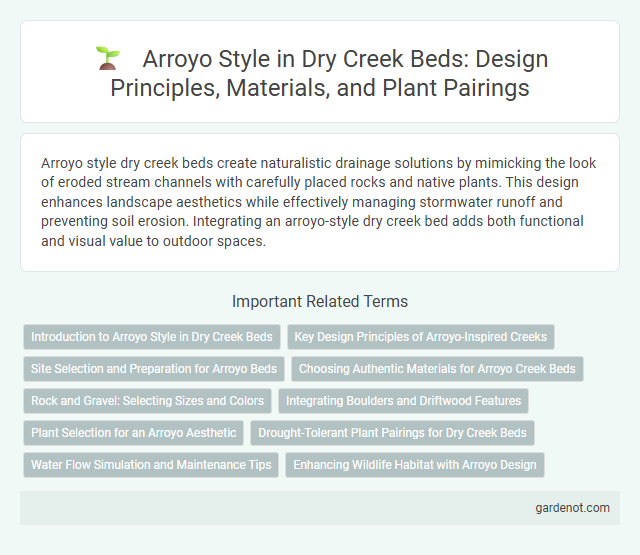Arroyo style dry creek beds create naturalistic drainage solutions by mimicking the look of eroded stream channels with carefully placed rocks and native plants. This design enhances landscape aesthetics while effectively managing stormwater runoff and preventing soil erosion. Integrating an arroyo-style dry creek bed adds both functional and visual value to outdoor spaces.
Introduction to Arroyo Style in Dry Creek Beds
Arroyo style in dry creek beds emphasizes natural water management by channeling intermittent flow through sloped, often rocky, corridors that mimic natural streams. This design enhances soil stabilization and controls erosion while promoting groundwater recharge in semi-arid landscapes. Incorporating native vegetation along arroyo channels improves habitat connectivity and supports local biodiversity.
Key Design Principles of Arroyo-Inspired Creeks
Arroyo-inspired creeks prioritize natural water flow patterns by incorporating steep gradients and intermittent flow to replicate dry creek bed conditions. Key design principles include using permeable substrates, such as gravel and sand, to enhance infiltration and support native vegetation adapted to arid environments. Designing curved, meandering channels with varying depths promotes sediment deposition and creates microhabitats that increase biodiversity and resilience.
Site Selection and Preparation for Arroyo Beds
Selecting a site for Arroyo style dry creek beds requires analyzing soil drainage, slope gradient, and sunlight exposure to ensure optimal water flow and plant health. Preparation involves excavating a shallow channel with a natural gradient, lining it with permeable materials like gravel and crushed stone to facilitate drainage, and compacting the subsoil to prevent erosion. Incorporating native, drought-tolerant vegetation enhances stability and mimics natural arroyos, supporting sustainable water management and ecosystem resilience.
Choosing Authentic Materials for Arroyo Creek Beds
Selecting authentic materials for Arroyo-style creek beds enhances natural aesthetics and durability. Incorporate native stones, such as granite or basalt, alongside local sand and gravel to mimic genuine arroyos. These materials support natural water flow and promote ecological balance in dry creek bed designs.
Rock and Gravel: Selecting Sizes and Colors
Choosing the right rock and gravel sizes for an Arroyo-style dry creek bed enhances both drainage and aesthetic appeal. Incorporate a mix of larger river rocks with smaller gravel to mimic natural water flow patterns and prevent erosion. Opt for earth tones such as grays, browns, and rusts to blend seamlessly with the surrounding landscape and emphasize the authentic desert appearance.
Integrating Boulders and Driftwood Features
Arroyo style dry creek beds effectively integrate boulders and driftwood to enhance natural aesthetics and improve water flow management. Strategically placed boulders create stability and prevent erosion, while driftwood adds organic texture and visual interest, mimicking authentic riverbed environments. Combining these features supports sustainable landscaping by promoting habitat diversity and natural water filtration processes.
Plant Selection for an Arroyo Aesthetic
Selecting drought-tolerant plants such as agave, yucca, and Mexican feather grass enhances the authentic Arroyo aesthetic in dry creek beds by mimicking natural desert landscapes. Incorporating native species like California poppy and desert marigold supports local ecosystems and ensures plant resilience in arid conditions. Succulents and ornamental grasses provide texture and color variation while requiring minimal irrigation, creating a sustainable and visually appealing Arroyo-style design.
Drought-Tolerant Plant Pairings for Dry Creek Beds
Arroyo-style dry creek beds thrive with drought-tolerant plant pairings such as Agave americana, Salvia greggii, and Muhlenbergia capillaris, which enhance erosion control and provide year-round visual interest. Incorporating native species like Artemisia tridentata and Penstemon parryi supports local ecosystems while minimizing water use. Mulching with gravel and selecting succulents like Echeveria and Sedum further optimize moisture retention and soil stability in arid landscapes.
Water Flow Simulation and Maintenance Tips
Arroyo-style dry creek beds are engineered to mimic natural water channels, using graded slopes and permeable materials to enhance efficient water flow simulation during rain events. Incorporating features such as strategically placed rocks and vegetation helps control erosion and directs runoff safely through the landscape. Regular maintenance involves clearing debris, inspecting for sediment buildup, and reinforcing banks to preserve optimal water flow and prevent structural damage.
Enhancing Wildlife Habitat with Arroyo Design
Implementing Arroyo-style design in dry creek beds enhances wildlife habitat by creating natural water retention zones that support native vegetation and provide shelter for diverse species. These designs mimic natural arroyo patterns, promoting groundwater recharge and reducing erosion while maintaining seasonal water flow essential for amphibians, birds, and small mammals. Integrating native plants and varied substrates in arroyo features fosters a resilient ecosystem that sustains biodiversity and promotes ecological balance.
Arroyo style Infographic

 gardenot.com
gardenot.com